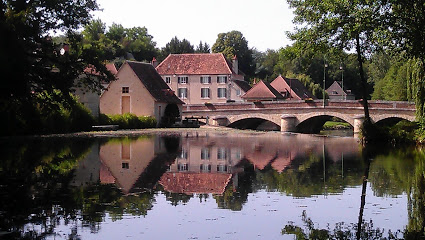Embracing Portability During My Residency at Atelier Melusine in France on 20-27 October 2019
- Marion Flanagan

- Nov 15, 2019
- 2 min read
Updated: Jul 20, 2021
Above left: Marion Flanagan working in the attic work space at Atelier Melusine in La Trimouille, France.
Above right: Bridge over La Benaize Riviere
My one-week arts residency at Atelier Melusine provided some time away from London during which to explore some ideas stemming from today's environmental crisis. Many thanks to British painter Sally Annett who provided lodging and work space in this beautiful village in the west of France. I travelled there taking 3 connecting trains to avoid the damaging carbon footprint created by flying: London to Paris, Paris to Poitiers, and then Poitiers to Montmorillon. The slower pace of train travel gave me time to read about Materiality and ponder the week ahead.
Wind turbines sighted on route to Paris, near Calais, France.
A key influence on my work during this time was the podcast series On Ecology produced by the Serpentine Gallery. I've been researching the interactions between humans and nature and this series investigated how current attitudes have let to a situation where humans are destroying the planet which we live on. Why would we take actions that could potentially threaten our own species? To break down this issue, they began by exploring ideas around how we see humans in relationship to nature. Have we become distanced from nature as a result of technology and the industrial revolution as the Romantics believed? Or have we forgotten that we are actually an inseparable part of nature as Timothy Morton, professor at Rice University, expresses in his talk: Nature Isn’t Real. Morton argues that the Anthropocene movement mistakenly focuses on human actions upon nature, thereby creating an imagined separation between humans from nature. He proposes that we shouldn’t “Other” nature, and instead, we need to view ourselves as a part of nature, "a being among beings".
I've introduced liquefied acrylic paint into my work since I've discovered that it's flowing trace well represents the organic forms of land, plants, and humans. When planning which materials to pack, I had to be able to carry my finished work home by train, so I chose to work on A2 Norfolk cartridge paper (210 GSM) and 4 bottles of Lascaux acrylic paints. After a very productive week, my host, Sally Annett, organized a viewing of my new work where I met the arts community in this region of France. (More detailed images of my work can be found in my next blog post.)

Visitors to the exhibition on 25 Oct 2019 (left and centre), and Sally Annett and I (right) with the artwork I donated to her atelier.
Upstairs room and main floor of exhibition.

Elevated view of Montmorillon, France during our post-exhibition tour of the area.






















Comments